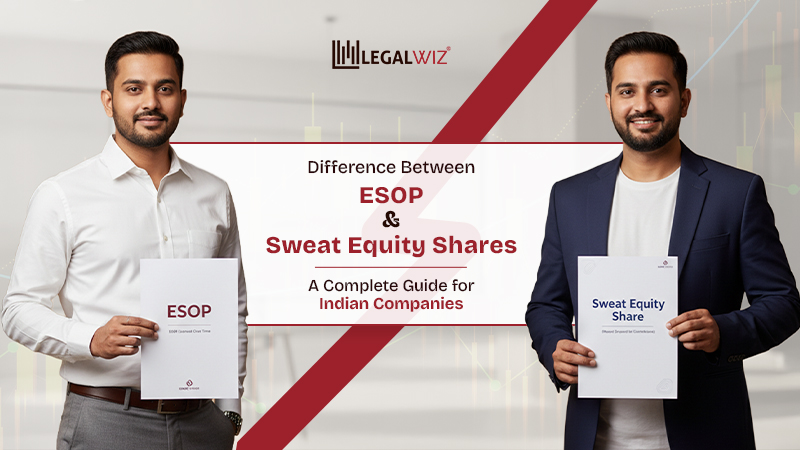Difference Between ESOP and Sweat Equity Shares
In the modern business scenario, equity is becoming one of the most convincing currencies to attract, retain, and reward talent. Thus, the most important question still remains for founders and HR leaders alike: should we issue ESOPs or sweat equity shares?
Whereas both are equity-based incentives, the main differences between ESOP and Sweat Equity Shares are with respect to timing, purpose, consideration, and compliance requirements. In this comprehensive guide, we will explain every key difference, from issuance procedures to taxation and legal limits, in order to help you determine what is best for your enterprise.
How are Shares Issued or Transferred? (Primary vs Secondary Transactions)
Before understanding ESOPs and Sweat Equity Shares, it is helpful to know the two basic ways companies can give equity to employees. These methods determine whether the company’s share capital changes and whether dilution occurs.
1. Primary Issuance
This is when the company creates and issues fresh shares and allots them directly to an employee or director.
What it means
- New shares are added to the company’s existing pool of equity.
- The total number of outstanding shares increases.
- This is an issuance by the company itself, not a transfer between individuals.
Where it applies
- ESOPs: When an employee exercises vested ESOP options, the company allots new shares to them.
- Sweat Equity Shares: Companies issue new shares under Section 54 in exchange for non cash contributions like know how or intellectual property.
Impact on dilution
- Yes, dilution occurs. When new shares are added, the ownership percentage of all existing shareholders decreases slightly.
- Primary issuance is the most common way companies expand ownership for employees.
2. Secondary Transfer
This is when existing shareholders transfer their own shares to an employee instead of the company issuing new ones.
What it means
- No new shares are created.
- Ownership simply shifts from one shareholder to another.
- This is handled through a standard share transfer form and consideration (if any) is paid to the transferring shareholder, not the company.
Where it applies
- Founder or promoter transfers: Often used to reward early team members before structured ESOPs exist.
- Investor-to-employee transfers: Sometimes used when the company wants to avoid increasing share capital.
- Reward-based transfers: When contributions need to be recognised but the company prefers not to issue fresh shares.
Impact on dilution
- No dilution. Share capital stays the same because no new shares are created.
- Only the ownership percentages of the transferring parties change.
What are Sweat Equity Shares?
Sweat equity shares are a company’s way of saying “thank you” to employees or directors who’ve contributed something valuable beyond just their regular work—think intellectual property, specialized know-how, or strategic insights that really moved the needle.
According to Section 2(88) and 54 of the Companies Act, 2013, sweat equity refers to issuing equity shares to employees or directors in exchange for things like technical expertise, intellectual property rights, or other meaningful contributions that add real value to the business.
Unlike ESOPs, which offer future ownership, sweat equity provides immediate shareholding in return for value contributed rather than payment.
Key Characteristics
- Issued at a Discount or for Non-Cash Contribution: Instead of paying full price, recipients get these shares at a reduced rate or in exchange for technical know-how, proprietary technology, patents, strategic contributions or any other valuable assets they bring to the table.
- Immediate Shareholding: On issuance, the recipient becomes a shareholder and has voting and dividend rights, unlike ESOPs that vest over time.
- Lock-in Requirement: The sweat equity shares have a statutory lock-in period of at least 3 years from the date of allotment.
- Valuation Mandatory: Before allotting sweat equity shares, the company must:
- Obtain a valuation of shares by a registered valuer.
- Obtain a valuation of the non-cash contribution (intellectual property, know-how, etc.).
- Attach these reports to the board and shareholder resolutions.
- Issuance Limits: According to Rule 8 (13) of the Companies (Share Capital and Debentures) Rules, 2014:
- A company can issue a maximum of 15% of its paid-up equity capital or shares of value ₹5 crore, whichever is higher, in a financial year.
- The sweat equity ceiling at any point in time cannot exceed 25% of the paid-up equity capital.
- For DPIIT-recognised startups, this cap increases to 50% for up to 10 years from incorporation.
When Companies Prefer Sweat Equity
- To incentivize founders, technical experts, or early-stage contributors.
- When cash compensation is not possible.
- To recognize intellectual property or strategic effort.
Example: Consider a startup’s CTO who developed a proprietary algorithm for the company, could receive sweat equity shares in recognition of his contribution instead of receiving additional cash compensation or a higher salary.
What Are Employee Stock Option Plans (ESOPs)?
An Employee Stock Option or an ESOP allows employees to buy company shares at a fixed price, also known as the exercise price under the condition that they complete a certain period with the company or achieve a specific milestone.
Think of ESOPs like a company’s way of inviting employees to be part owners by buying shares at a predetermined price. But obviously the employees need to earn this by usually completing a specific tenure in the company or accomplishing certain performance goals. Unlike Sweat Equity Shares which reward past efforts, ESOPs are forward-looking recognition designed to motivate ongoing and future contributions of the employees.
Under Section 62(1)(b) of the Companies Act, 2013, a company may issue ESOPs through a special resolution passed by the shareholders. Companies decide the exercise price, which may be at FMV, at a premium, or at a discount depending on the scheme.
Key Characteristics
- Right to Buy, Not Obligation: The employee is granted an option to buy shares later, not immediate ownership.
- Vesting Period: ESOPs become exercisable after a defined vesting period, typically 1 to 4 years.
- Exercise Price: Employees pay a fixed exercise price to convert their vested options into actual shares.
- Regulatory Framework:
- Unlisted companies: Companies (Share Capital and Debentures) Rules, 2014
- Listed companies: Shall have to comply with the SEBI (Share Based Employee Benefits and Sweat Equity) Regulations, 2021 as amended in September 2025.
- No Immediate Ownership: Employees get equity only after exercising vested options and receiving allotment.
When Companies Prefer ESOPs
- To motivate employees to perform better.
- To retain key talent long-term.
- In order to align employees’ interests with the growth of the company.
Example: Consider an employee who joins a Series A startup and is granted ESOPs that vest over 3 years. This structure encourages them to stay with the company and aligns their interests with its long-term growth.
ESOPs involve drafting a scheme, issuance of Letter of Grant, establishing vesting and exercise timelines, and management of the tax at exercise and sale. For a practical, section-wise guide that covers each of these steps in detail, read our guide on understanding employee stock options (ESOP).
Promoters and ESOPs: What the Law Says
According to Rule 12(1) of the Companies (Share Capital and Debentures) Rules, 2014, ESOPs cannot be issued by a company, generally, to:
- Promoters or persons belonging to the promoter group, and
- Directors holding more than 10% of the company’s equity.
However, there is a special relaxation for DPIIT-recognised startups. They can issue ESOPs to their promoters/directors who are also employees, for a period of up to 10 years from the date of incorporation.
The rule permits the start-up to incentivize founders who are actively involved in the operations without breaching ownership and control restrictions.
Key Terms Simplified
| Term | Meaning |
| Vesting | The period an employee must stay with the company before earning the right to exercise their stock options. |
| Exercise Price | The fixed price employees pay to buy shares once their options vest. |
| Exercise | The act of converting vested options into actual company shares by paying the exercise price. |
| Lock-in Period | The mandatory time during which issued shares (like sweat equity) cannot be sold or transferred. |
| Fair Market Value (FMV) | The share value determined by a registered valuer, used for pricing and taxation. |
| Dilution | Reduction in ownership percentage when new shares are issued. |
| Perquisite Tax | Income tax applied to non-cash benefits like ESOPs or discounted shares. |
Detailed Comparison: Sweat Equity Shares vs Employee Stock Options (ESOPs)
| Category | ESOPs | Sweat Equity Shares |
| Purpose | To motivate and retain employees for future performance | To reward past work, expertise, know how or IP already contributed |
| Nature of Benefit | A right or option to buy company shares later | Immediate allotment of actual shares |
| Eligibility | Employees, employees of subsidiary/holding, and directors, except promoters and directors holding more than 10% (unless DPIIT-recognised startup) | Employees and directors including whole time and managing directors |
| Governing Law | Section 62(1)(b) of Companies Act, Rule 12 of Share Capital and Debentures Rules | Section 54 of Companies Act, Rule 8 of Share Capital and Debentures Rules |
| Regulator for Listed Companies | SEBI (SBEB and Sweat Equity) Regulations 2021 | SEBI (SBEB and Sweat Equity) Regulations 2021 |
| When Ownership Is Received | Only after employee exercises the vested ESOP | Immediately on allotment |
| Type of Consideration | Cash payment. Employee pays exercise price to get shares | Non cash. Given in exchange for know how, IP, technical value or strategic contribution |
| Vesting Requirement | Mandatory minimum of one year vesting | No vesting requirement |
| Lock in Requirement | Not mandatory unless the ESOP policy includes one | Mandatory three year lock in for all sweat equity shares |
| Dilution Impact | Happens only when employees exercise their options | Happens immediately on issuance since new shares are allotted |
| Share Issuance Type | Primary issuance when exercised | Primary issuance on allotment |
| Secondary Transfer Applicability | Possible only if founders or investors sell their shares to employees outside the ESOP scheme | Not applicable because sweat equity can only be issued by company itself |
| Valuation Requirements | FMV required at grant and again at exercise for tax purposes | Valuation of shares plus valuation of non cash consideration required before issuance |
| Pricing | Exercise price decided by the company. Can be at discount or premium | Price determined based on valuation. Can be issued at discount since it rewards contribution |
| Tax at Grant | No tax at grant stage | Taxable as perquisite on FMV minus any consideration paid |
| Tax at Exercise | Taxed as perquisite (Section 17(2)(vi)) on FMV minus exercise price. | Not applicable since they already received shares |
| Tax at Sale | Capital gains tax based on holding period | Capital gains tax based on holding period |
| Income Tax Section Applicable | Section 17(2) for perquisite taxation | Section 17(2) for perquisite taxation |
| TDS Requirement | Employer must deduct TDS at exercise | Employer must deduct TDS at allotment |
| Accounting Treatment | Expense amortised over vesting period | Expense recognized immediately on issuance |
| Shareholder Approval Needed | Special resolution | Special resolution |
| Board Approvals Needed | Yes at grant, vesting and allotment stages | Yes before allotment including valuation approval |
| Documents Required | ESOP policy, grant letters, exercise forms, registers, MGT 14 | Valuation report, board resolution, shareholder resolution, SH 3 filing |
| ROC Filings | MGT 14 for resolutions, PAS 3 for allotment | SH 3 for allotment, MGT 14 for special resolution |
| Best For | Long term retention, performance driven roles, steady company growth | Founders, early contributors, technical experts, people creating IP or strategic value |
| Cash Outflow for Employee | Yes. Employee must pay exercise price | No cash payment needed |
| Impact on Company Cash Flow | Company collects exercise money when options are exercised | No cash received by company since issued for value contribution |
| Risk for Employee | Must pay exercise price. Value may fall after exercise | No financial risk because no cash is paid |
| Common Use Cases | Growth-stage startups, tech employees, leadership, core teams | Early stage contributors, founders, CTOs, IP creators, R and D roles |
| Restrictions | Promoters and 10 percent shareholders cannot receive ESOPs except DPIIT startups | No such promoter restrictions. But valuation and lock in are mandatory |
| Perception Among Employees | Seen as future upside reward | Seen as higher-value recognition since shares are issued immediately |
Legal & Compliance Checklist
For Sweat Equity Shares
- Must be authorized by the Articles of Association.
- Special resolution by shareholders.
- Valuation by a registered valuer for both shares and non-cash contributions.
- Filing of Form SH-3 with the Registrar of Companies.
- Disclosure in the Board’s report.
For ESOPs
- Draft and approve the ESOP policy.
- Obtain shareholder approval via special resolution.
- Maintain the ESOP register and vesting records.
- File Form MGT-14 for board/shareholder resolutions.
Before issuing ESOPs, the companies have to get shareholder approval by a special resolution, which is demanded under Section 62(1)(b). This approval gets legally valid only on filing Form MGT-14 with ROC. Check out our comprehensive blog on Form MGT 14 explained for a complete walkthrough of its purpose, due date and filing requirements. - Follow SEBI guidelines (if listed).
Latest Regulatory & Market Insights 2025
- SEBI Amendments as of September 2025:
Simplified provisions for startups issuing ESOPs and sweat equity shares.
Founders eligible for ESOPs can now retain them post-IPO filing. - Startup Incentives:
DPIIT-recognised startups can issue sweat equity shares up to 50% of paid-up capital within 10 years. - Corporate Trend:
Founders’ sweat equity and employees’ ESOPs are increasingly being combined in startups to create balanced ownership and retention.
Tax Implications
| Stage | Sweat Equity | ESOP |
| At Grant | Taxed as perquisite on FMV difference | No tax until exercise |
| At Exercise | Not applicable | Taxed as perquisite on FMV – Exercise Price |
| At Sale | Capital Gains Tax | Capital Gains Tax |
Tip: Always get a 409A or merchant banker valuation to ensure FMV accuracy and avoid compliance risks.
Note: Employers must deduct TDS under Section 192 on the perquisite value at the time of exercise (for ESOPs) or allotment (for sweat equity).
How LegalWiz.in Can Help
Whether you’re a founder designing your first ESOP policy or a director planning to issue sweat equity shares, LegalWiz.in helps you do this the right way.
Our experts can assist with:
- Drafting ESOP and Sweat Equity Schemes
- Board & shareholder resolutions
- Valuation and compliance documentation
- ROC filings and regulatory adherence
Conclusion
Both Sweat Equity Shares and ESOPs are designed to achieve the same thing, that is to build a culture of ownership, encourage loyalty and reward people who have helped the company to become successful. The main difference comes down to one thing that is their timing. Sweat equity recognises contributions that have already been made while ESOPs are forward looking, designed to motivate ongoing and future performance.
Deciding on which option suits your company depends upon a few key factors such as your financial state, your talent retention goals and your legal compliance requirements. That’s where LegalWiz comes in to help you design, issue and manage equity-based rewards in a way that is straightforward, transparent and fully compliant. Need help getting started? Just fill out a few details and our expert team will connect with you right away helping you navigate the issuance of ESOP or Sweat Equity the right way.
Frequently Asked Questions
Can a startup issue both ESOPs and sweat equity shares?
Yes, provided the company complies with Section 54 for the issue of sweat equity and Section 62(1)(b) for the issue of ESOPs.
Can sweat equity be issued to non-employees?
No sweat equity is reserved specifically for the people working within the company, that includes employees and directors (including whole-time and managing directors). Consultants, advisors or external partners are not eligible under current regulations.
What is the minimum vesting period for ESOPs?
One year from the date of grant according to the Companies (Share Capital and Debentures) Rules, 2014.
Are sweat equity shares taxable?
Yes. Fair market value minus consideration received, if any, is taxed as a perquisite.
Can a director receive ESOPs?
Yes, both executive and non-executive directors can be eligible, provided the scheme permits it.

Amisha Shah
Amisha Shah heads content at LegalWiz.in, where she transforms complex legal concepts into clear, actionable insights. With extensive experience in legal, fintech, and business services, she helps startups and enterprises navigate regulatory challenges through engaging, accurate content that empowers informed business decisions.



